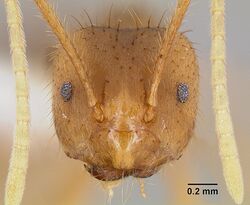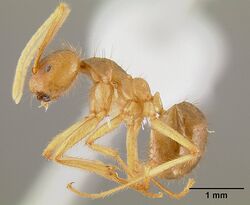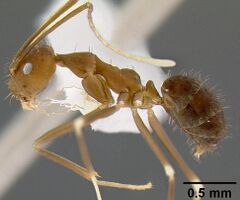Key to Prenolepis Group Genera (Formicinae)
This key to the genera of the Prenolepis genus-group is based on: Williams, J.L., LaPolla, J.S. 2016. Taxonomic revision and phylogeny of the ant genus Prenolepis (Hymenoptera: Formicidae). Zootaxa 4200(2): 201–258. doi:10.11646/zootaxa.4200.2.1
This key in turn is based on the original Prenolepis genus-group key by LaPolla et al. (2009) and subsequent modifications: LaPolla et al. (2012) and LaPolla & Fisher (2014) .
1
- Mesonotal and metanotal sutures deep and complete, dividing posterior part of mesosoma into mesopleuron and propodeum (Figs 29–31, 33, 34) . . . . . 2
- Mesonotal and metanotal sutures absent or shallow and incomplete (Figs 15–27, 32, 35–37) . . . . . 5
2
return to couplet #1
- Maxillary palps with 5 or fewer segments; usually with standing macrosetae on propodeum; species often strongly polymorphic, with a major and minor caste expressed . . . . . 3
- Maxillary palps with 6 segments; no standing macrosetae on propodeum; species monomorphic to slightly polymorphic, with no discernable major or minor caste expressed . . . . . 4
3
return to couplet #2
- Eyes large, REL typically greater-than or equal to 20 (except in E. negrosensis); labial palps typically with 4 segments; man-dalus large, conspicuous, and usually visible without dissection of mandible . . . . . Euprenolepis
- Eyes small, REL less-than 20 (typically 15 or less); labial palps typically with 2 or 3 segments; mandalus small, inconspicuous, and usually not visible without dissection of mandible . . . . . Pseudolasius
4
return to couplet #2
- Compound eyes placed slightly anterior to the midline of head (EPI < 100); mandibles usually with 6 teeth on the masticatory margin, but sometimes 7; ectal surface of mandibles without longitudinal striations . . . . . Nylanderia
- Compound eyes placed slightly posterior to the midline of head (EPI > 110) (except in P. umbra, which has eyes slightly anterior to the midline); mandibles with 5–8 teeth on the masticatory margin; ectal surface of mandibles with longitudinal striations . . . . . Paratrechina
5
return to couplet #1
- Compound eyes typically placed slightly posterior to the midline of head (EPI range 110–120); two pairs of erect setae on the pronotum, one pair on the mesonotum, and one pair on the propodeum; erect setae on head form a pattern of four setae along posterior margin and six or seven rows from posterior margin to clypeal margin; dorsal face of propodeum typically short and angular; femora and tibiae lacking erect macrosetae . . . . . Paraparatrechina
- Compound eyes placed far posterior to the midline of head (EPI > 120); erect setae not in paired rows, but instead scattered across posterior margin of head, mesosoma, and gaster . . . . . 6
6
return to couplet #5
- In profile view, mesosoma with a strong mesonotal constriction and a mesonotal depression posterior to pronotum (Figs 15– 27); at the constriction, longitudinal rugae extend from mesonotum to mesopleuron; erect macrosetae on head, mesosoma, and gaster thin and wispy . . . . . Prenolepis
- In profile view, the mesosoma is gracile with an elongate and flattened dorsal surface of the mesonotum (Figs 36–37); erect macrosetae on head, mesosoma, and gaster with thick setal bases, usually dark in color . . . . . Zatania
References
- LaPolla, J. S., S. G. Brady, and S. O. Shattuck. 2010. Phylogeny and taxonomy of the Prenolepis genus-group of ants (Hymenoptera: Formicidae). Systematic Entomology. 35:118-131.
- LaPolla, J.S. & Fisher, B.L. 2014. Then there were five: a reexamination of the ant genus Paratrechina (Hymenoptera, Formicidae). ZooKeys 422, 35–48 (doi: 10.3897/zookeys.422.7779).
- LaPolla, J. S., R. J. Kallal, and S. G. Brady. 2012. A new ant genus from the Greater Antilles and Central America, Zatania (Hymenoptera: Formicidae), exemplifies the utility of male and molecular character systems. Systematic Entomology. 37(1):200-214.













